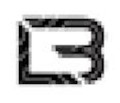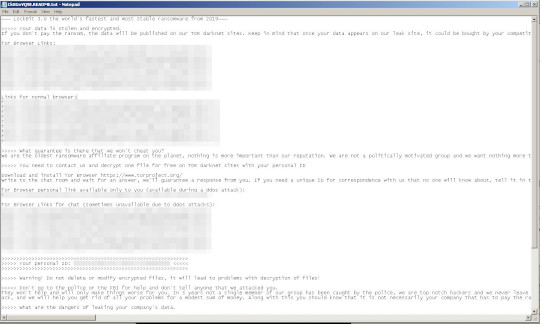Ransom.Win32.LOCKBIT.EOD
Windows


Threat Type: Ransomware
Destructiveness: No
Encrypted: Yes
In the wild: Yes
OVERVIEW
This Ransomware arrives on a system as a file dropped by other malware or as a file downloaded unknowingly by users when visiting malicious sites.
It drops files as ransom note. It avoids encrypting files with the following file extensions.
TECHNICAL DETAILS
Arrival Details
This Ransomware arrives on a system as a file dropped by other malware or as a file downloaded unknowingly by users when visiting malicious sites.
Installation
This Ransomware injects codes into the following process(es):
- explorer.exe
- notepad.exe
Autostart Technique
This Ransomware drops the following files:
- %ProgramData%\Ck8GvVQ9E.ico

Other System Modifications
This Ransomware adds the following registry entries as part of its installation routine:
HKEY_LOCALMACHINE\SOFTWARE\Classes\
Ck8GvVQ9E\DefaultIcon
(Default) = %ProgramData%Ck8GvVQ9E.ico
HKEY_LOCAL_MACHINE\SOFTWARE\Classes\
.Ck8GvVQ9E
(Default) = Ck8GvVQ9E
HKEY_LOCAL_MACHINE\SOFTWARE\Microsoft\
Windows\CurrentVersion\Explorer
GlobalAssocChangedCounter = 0x00000027(39)
It adds the following registry keys as part of its installation routine:
HKEY_LOCAL_MACHINE\SOFTWARE\Classes\
.Ck8GvVQ9E
HKEY_LOCAL_MACHINE\SOFTWARE\Classes\
Ck8GvVQ9E
HKEY_LOCALMACHINE\SOFTWARE\Classes\
Ck8GvVQ9E\DefaultIcon
Process Termination
This Ransomware terminates the following processes if found running in the affected system's memory:
- agntsvc
- calc
- dbeng50
- dbsnmp
- encsvc
- excel
- firefox
- infopath
- isqlplussvc
- msaccess
- mspub
- mydesktopqos
- mydesktopservice
- notepad
- ocautoupds
- ocomm
- ocssd
- onedrive
- onenote
- oracle
- outlook
- powerpnt
- sqbcoreservice
- sql
- steam
- synctime
- tbirdconfig
- thebat
- thunderbird
- visio
- winword
- wordpad
- wuauclt
- xfssvccon
Other Details
This Ransomware requires the following additional components to properly run:
- LBB.bin → Encrypted Lockbit Ransomware
It does the following:
- If not executed with admin rights, it will attempt relaunch itself as admin by elevating its privileges via bypassing UAC.
- It encrypts fixed, removable and network drives
- It deletes files in recycle bin folder for removable and fixed drives
- It uses WQL to delete shadow copies
- It terminates if the machine has the following system language:
- Arabic (Syria)
- Armenian
- Azerbaijani (Cyrillic)
- Azerbaijani (Latin)
- Belarusian
- Georgian
- Kazakh
- Kyrgyz (Cyrillic)
- Romanian (Moldova)
- Russian
- Russian (Moldova)
- Tajik
- Tatar
- Turkmen
- Ukrainian
- Uzbek (Cyrillic)
- Uzbek (Latin)
- It deletes services with the following strings:
- backup
- GxBlr
- GxCIMgr
- GxCVD
- GxFWD
- GxVss
- memtas
- mepocs
- msexchange
- sophos
- sql
- svc$
- veeam
- vss
- It deletes the following services:
- WdBoot
- WdFilter
- WdNisDrv
- WdNisSvc
- WinDefend
- wscsvc
- sppsvc
- Sense
- SecurityHealthService
- Change the icon of encrypted file with %ProgramData%\Ck8GvVQ9E.ico
(Note: %ProgramData% is a version of the Program Files folder where any user on a multi-user computer can make changes to programs. This contains application data for all users. This is usually C:\ProgramData on Windows Vista, 7, 8, 8.1, 2008(64-bit), 2012(64-bit) and 10(64-bit), or C:\Documents and Settings\All Users on Windows Server 2003(32-bit), 2000(32-bit) and XP.)
It accepts the following parameters:
- -psex →Performs lateral movement via admin shares
- -gspd →Performs group policy modification for lateral movement
- -pass{value} →Uses the first 32 characters of the value as a key to decrypt the main routine (This is required for the ransomware to execute properly.)
- -safe →Reboots in SafeBoot
Ransomware Routine
This Ransomware avoids encrypting files with the following strings in their file name:
- autorun.inf
- boot.ini
- bootfont.bin
- bootsect.bak
- d3d9caps.dat
- desktop.ini
- GDIPFONTCACHEV1.DAT
- iconcache.db
- ntldr
- ntuser.dat
- ntuser.dat.log
- ntuser.ini
- thumbs.db
It avoids encrypting files found in the following folders:
- $recycle.bin
- $windows.~bt
- $windows.~ws
- all users
- boot
- config.msi
- default
- intel
- microsoft
- msocache
- perflogs
- program files
- program files (x86)
- programdata
- public
- system volume information
- tor browser
- windows
- windows.old
- x64dbg
It renames encrypted files using the following names:
- {Random Characters}.Ck8GvVQ9E
It drops the following file(s) as ransom note:
- {Encrypted Directory}\Ck8GvVQ9E.README.txt

It avoids encrypting files with the following file extensions:
- 386
- .adv
- .ani
- .bat
- .bin
- .cab
- .cmd
- .com
- .cpl
- .cur
- .deskthemepack
- .diagcab
- .diagcfg
- .diagpkg
- .dll
- .drv
- .exe
- .hlp
- .hta
- .icl
- .icns
- .ico
- .ics
- .idx
- .key
- .ldf
- .lnk
- .lock
- .mod
- .mpa
- .msc
- .msi
- .msp
- .msstyles
- .msu
- .nls
- .nomedia
- .ocx
- .pdb
- .prf
- .ps1
- .rom
- .rtp
- .scr
- .search-ms
- .shs
- .spl
- .sys
- .theme
- .themepack
- .wpx
SOLUTION
Step 1
Before doing any scans, Windows 7, Windows 8, Windows 8.1, and Windows 10 users must disable System Restore to allow full scanning of their computers.
Step 2
Search and delete this file
- %ProgramData%\Ck8GvVQ9E.ico
Step 3
Delete this registry key
Important: Editing the Windows Registry incorrectly can lead to irreversible system malfunction. Please do this step only if you know how or you can ask assistance from your system administrator. Else, check this Microsoft article first before modifying your computer's registry. Before you could do this, you must restart in Safe Mode. For instructions on how to do this, you may refer to this page If the preceding step requires you to restart in safe mode, you may proceed to edit the system registry.
- In HKEY_LOCAL_MACHINE\SOFTWARE\Classes\
- .Ck8GvVQ9E
- .Ck8GvVQ9E
- In HKEY_LOCAL_MACHINE\SOFTWARE\Classes\
- Ck8GvVQ9E
- Ck8GvVQ9E
- In HKEY_LOCAL_MACHINE\SOFTWARE\Classes\Ck8GvVQ9E\
- DefaultIcon
- DefaultIcon
Step 4
Delete this registry value
Important: Editing the Windows Registry incorrectly can lead to irreversible system malfunction. Please do this step only if you know how or you can ask assistance from your system administrator. Else, check this Microsoft article first before modifying your computer's registry.
- In HKEY_LOCAL_MACHINE\SOFTWARE\Classes\.Ck8GvVQ9E
- (Default) = Ck8GvVQ9E
- (Default) = Ck8GvVQ9E
- In HKEY_LOCAL_MACHINE\SOFTWARE\Classes\Ck8GvVQ9E\DefaultIcon
- (Default) = %ProgramData%Ck8GvVQ9E.ico
- (Default) = %ProgramData%Ck8GvVQ9E.ico
- In HKEY_LOCAL_MACHINE\SOFTWARE\Microsoft\Windows\CurrentVersio
- Explorer GlobalAssocChangedCounter = 0x00000027(39)
- Explorer GlobalAssocChangedCounter = 0x00000027(39)
Step 5
Scan your computer with your Trend Micro product to delete files detected as Ransom.Win32.LOCKBIT.EOD. If the detected files have already been cleaned, deleted, or quarantined by your Trend Micro product, no further step is required. You may opt to simply delete the quarantined files. Please check the following Trend Micro Support pages for more information:
Did this description help? Tell us how we did.

